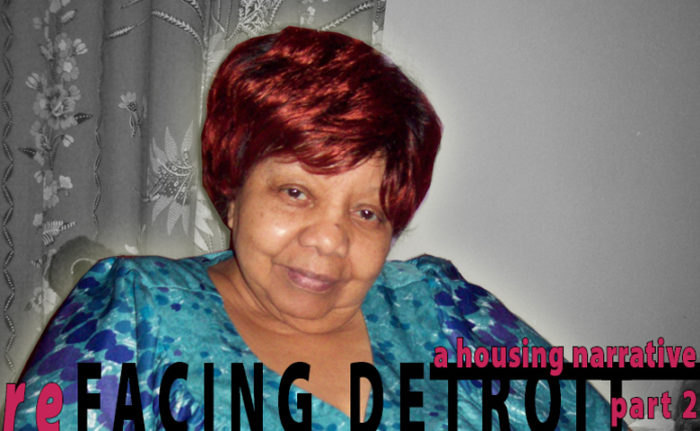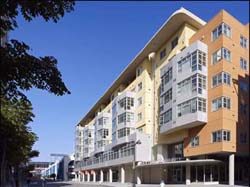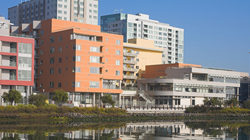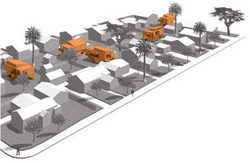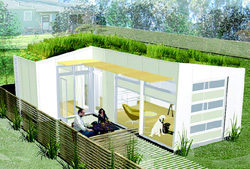reFACING DETROIT : A HOUSING NARRATIVE : PART 2
Paying Respect to our Detroit Elders: Housing Narrative – Part 2
[Part two in a series chronicling our experiences assisting the Detroit Housing Commission (DHC). For further description, refer to our first housing narrative post.]
House No. 3: My car’s wipers intermittently clear our line of sight. My colleague and I drive past two vacant homes, a vacant school, three vacant lots, and a vacant business. Finally, we turn onto a block where most of the houses seem to be intact. The rain is pouring down and we are unprepared. Holding clip boards over our heads, we make a dash to the home’s covered porch.
We ring the doorbell. “Who is it?” an elderly woman yells through a door that remains locked. I answer that we are doing a survey for the Detroit Housing Commission. “I don’t know anything about a survey” she answers. I offer that she can call someone with the Housing Commission and she can confirm our presence with them. The door cracks open. She asks for ID. I offer her a photoless ID as I also start to call my contact at the Housing Commission. Handing the phone to her, she speaks to the person. After a brief conversation, she re-opens the door and only allows me inside. My colleague is left to stand in the rain. I begin the survey. The elderly woman silently follows me into every room.
- From file “056_ras” entitled “ra06JohnPeterson3.qxd” page 01
Aging in Place. The statistics are striking. 89% of 50+ year old Americans intend to remain in their own homes as long as they possibly can. Experts define this as “aging in place.” According to a 2003 National Transportation Availability and Use Survey, 3.5 million Americans never leave their homes, and more than half of the homebound are people with disabilities.
As designers, we must address these striking statistics. With 13.5% of Detroit’s population at or over the age of 60, designers must help the City attract and retain its senior population. As concluded by the American Association of Retired Persons (AARP), we must create, “…communities that design for livability, empower their residents to remain independent and engaged, and offer a better quality of life.”
According to the AARP, there are three factors that control senior quality of life: independence, comfort and health. The following projects are meant to demonstrate designers’ attempts to improve these factors for one of the most at risk urban demographic: Seniors.
House No. 12: We returned to this particular house for the second time. This time, the tenant opened the door. The home was dark and filled with a lifetime of furnishings. The memories so bountiful, I could barely open bedroom doors or walk in basements. I explained the purpose of our survey, trying to alleviate concerns that the elderly tenant might be relocated to high rise senior apartment or nursing home.
Independence. In 2005, the City of Santa Cruz won awards from the American Planning Association (APA) and the American Institute of Architects (AIA) for their efforts to give seniors independence. The award winning program amends the zoning ordinance to allow for accessory dwelling units. Accessory units are separate ±500 square foot residences that may be attached to the main house or located elsewhere on a residential lot. With an accessory unit, seniors have an opportunity to draw additional income or live with an additional family member. More importantly, the flexibility of these dwelling units allows seniors to continue living independently while maintaining connections to community and family.
House No. 21: A jovial woman in a motorized chair answers the door. Glancing around the unit, I notice that every partition is scored horizontally at a consistent height about 30” from the floor. She explains that for the first couple of weeks after receiving her chair, she was unable to adjust the arm rests. I begin to ask questions about her mobility, recognizing the DHC’s commitment to meeting t the needs of its disabled residents. Neighbor’s help her with navigating her front steps. She agrees with my suggestion to add a chair and grab bars within the shower area. I notice the kitchen is also not wheelchair accessible. None of the countertop heights are adjusted to barrier-free standards.
Comfort. In an effort to improve homeowner comfort, a coalition of Georgian homebuilders and advocates, including the AARP, developed the EasyLiving Home Program. The program features three primary design features:
Easy Access – a step free entrance with a threshold not more than one-half inch rise from a route into the main floor.
Easy Passage – a minimum of 32 inches of clear passage for every interior passage door on the main floor, including bathrooms, and the exterior.
Easy Use – at least one bedroom, a kitchen, some entertainment area, and one full bathroom located on the main floor.
House No. 52: As I begin the survey, I notice an elderly woman sitting in a living room. Her hair is being combed. She is singing in a soft childlike voice – a nursery rhyme. A younger woman continues to gently stroke her hair. I catch the elderly woman’s eyes and say hello. I get no response, just a blank stare. I look away and can feel her eyes watching me as I move into the kitchen.
Health. Keeping seniors connected to community and family is key to giving them access to services. In the words of Mitch Green, former chairman of the AIA Design for Aging Group, “Until now, residents have been moved into different rooms or wings when they require more intensive care. Tomorrow’s residents will want to remain in their apartments and have the care brought to them.” He continues by pointing out that architects will need to design communities that can accommodate health care services wherever they’re requested. This is particularly relevant to Detroit, where 89% of seniors surveyed suffer from at least one chronic illness.
Beacon Hill Village is a membership organization in the heart of Boston. Begun in 2001, it enables a growing and diverse group of Boston senior residents to stay in their homes by organizing and delivering programs and services that allow them to lead safe, healthy productive lives in their own homes. Organized as a cooperative, people buy shares and have access to a wide variety of social options, learning opportunities, health and wellness choices and health care. It is a model being replicated nationally.
Livable Communities. The AARP defines livable communities as, “… one that has affordable and appropriate housing, supportive community features and services and adequate mobility options. Together these facilitate personal independence and the engagement of residents in civil and social life.”
Developed by Mercy Housing California, the $43.7 million dollar Mission Creek Senior Community project combines 140 apartments with the City of San Francisco’s first new library branch in over 40 years. According to Affordable Housing Finance magazine, its site was chosen for its “peaceful location in a vibrant, service-enriched neighborhood that is highly accessible by public transit…”
One of the important components of the development is the Adult Day Health Center (ADHC). Pioneering a unique service model, the sponsors provide onsite adult day health services to both residents of the building and those living within the neighboring community. In doing so, they are able to keep a local senior population that is plagued by behavior and metal health issues out of nursing homes and aging in their own homes.
Solutions for the 21st Century. A recent report by the Detroit Area Agency for the Aging (DAAA) concludes that our City’s, “older adult population is dying at a dramatically higher rate than their counterparts who live in other parts of the state of Michigan…”
The needs of Detroitseniors are very simple. They desire spaces that:
- Evolve with their physical needs
- Remain connected to community services and family
- Costs are compatible with their incomes
They desire livable communities that help them remain independent and engaged. Their needs are simple, but the solutions are complex. The design community is currently missing an opportunity. Michael Graves, who struggles with his own disability, states:
“Just as the Renaissance was an explosion of design and technology that reflected an infusion of new public participation in European life at the end of the Middle Ages, architecture and design are being asked to create tools and spaces for a new diverse 21st century public.”
Let’s help put Detroitat the forefront of finding 21st century solutions.





